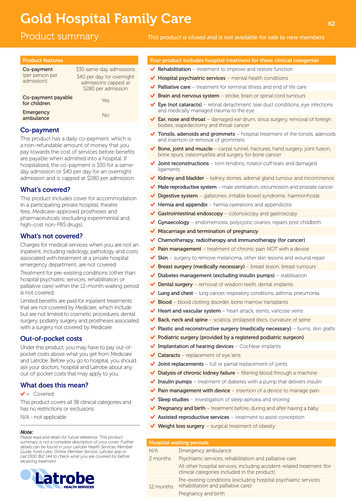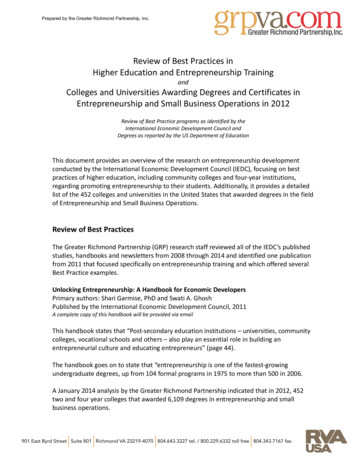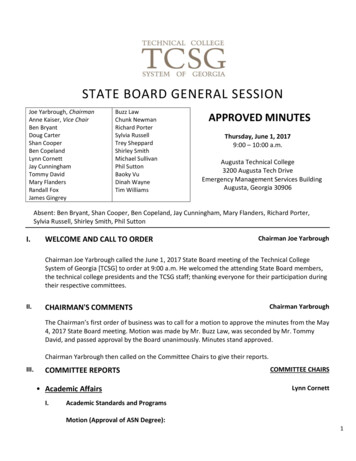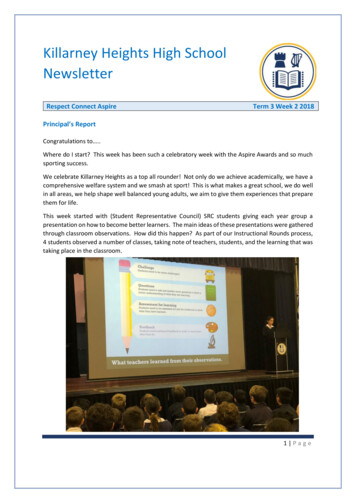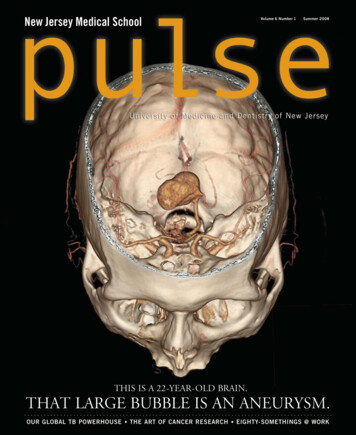
Transcription
Volume 6 Number 1Summer 2008This is a 22-year-old brain.That large bubble is an Aneurysm.OUR GLOBAL TB POWERHOUSE THE ART OF CANCER RESEARCH EIGHTY- SOMETHINGS @ WORK
Message from the DeanAnother school year has come and gone at New Jersey Medical School. This past May, we watched142 graduating members of the Class of 2008 make the transition from their roles as students tothat of doctors. As these stellar individuals face the next stage of their medical training in theirrespective residency programs, I’m confident they will continue to make us proud.There’s a lot for us to be proud of at New Jersey Medical School: Our match rate of 97 percent remains well above the national average. That means the vast majorityof our students are able to parlay the top-notch training they receive here into their first jobs as doctorsin residency programs at some of the nation’s most prestigious institutions. We continue to be a place where high-quality science is conducted. One needn’t look much furtherthan the grants our scientists are receiving to know the type of cutting-edge and highly regarded researchthat takes place here. Our Admissions Office is as busy as ever, fielding thousands of applications from aspiring medicalstudents to fill just 170 spots. Our faculty members remain steadfast in their commitment to providing quality medical care that’sdefined by compassion.In this issue of Pulse, you will read more about projects and programs run by our faculty, staff and students as well as other achievements that make New Jersey Medical School a place we all can be proud of.In health,Robert L. Johnson, MD, FAAPThe Sharon and Joseph L. Muscarelle Endowed Dean (Interim)pulseInterim DeanUMDNJ – New Jersey Medical SchoolRobert L. Johnson, MDDirectorUniversity Marketing CommunicationsBarbara HurleyExecutive Director for AdministrationWalter L. Douglas, Jr.DirectorNJMS Marketing CommunicationsGenene MorrisJOHN EMERSONVOLUME 6 NUMBER 1Senior Editor, NJMS PulseMaryann BrinleyContributing WritersKaylyn Kendall DinesJennifer S. DoktorskiFlorence IsaacsEve JacobsLisa JacobsJoni ScanlonJill SpotzSUMMER 2008PresidentNJMS Alumni Associationand AlumniFocus EditorJoseph V. DiTrolio, MDAlumniFocus CoordinatorDianne MinkDesignSherer Graphic DesignUNIVERSITY OF MEDICINE & DENTISTRY OF NEW JERSEYKeep In Touch NJMS Pulse is published twice each year by the UMDNJ–Department of University Affairs for New Jersey MedicalSchool (NJMS). We welcome letters to the editor andsuggestions for future articles.Send all correspondence to:Pulse EditorOffice of University Marketing CommunicationsUniversity Heights –P.O. Box 1709, Room 132865 Bergen StreetNewark, NJ 07101–1709or via email to njmspulse@umdnj.edu
pulseSummer 2008INSIDE INFORMATION2 How Do You Measure Success? Try Match DayCounty by County, Respira Grows3 New Jersey Journal of Medicine LaunchedBarbers Recruited to Fight Cancer4 Sunday in the Park, Racing for a CureStraight Talk for TeensLeevy’s Legacy5 NJMS News by the NumbersA Motown Miracle in a Musical MomentA CLOSER LOOK 156 At Our Endowed Chairs10 At The Power of Hormones12 At www.ePlasty18NJMS PEOPLE: DO YOU KNOW?14151617Hamid Bagce, Student Inventor at WorkNoreen Gomez, Art is Her PassionSylvia Voorheis & Eileen Quirk, Eighty-SomethingsKudosFEATURES2418 Inside the Admissions OfficeA peek at the harsh realities behind the scenes22 Doctor Who?Taking the mini-version of med school24 The Aneurysm AnswerOn the way to solving a neurological nightmare28 Inside Our Global TB PowerhouseThe battle to stop a catastrophe in the making30 Growing Great ResearchersThe art of mixing the clinical and scientific sides of cancer medicineALUMNIFOCUS34 News of Special Interest to NJMS Graduates36 To Send Med Students into NewarkOh, The Places You Will Go37 Class Notes: Are You in this Picture?40FOCUS ON PHILANTHROPY40 How Kirby Makes All the Right Connections28COVER: COURTESY OF CHARLES PRESTIGIACOMO, MD, AND WENZHUAN HE, MD
I N S I D E I N F O R M AT I O NCounty by County,RESPIRA GrowsRESPIRA , the NJMS bilingualprogram teaching children andparents about asthma triggers, symptoms and disease management, grewby three counties recently. Starting in2006, the innovative initiative servedfamilies in Essex and Union, butnew funds— 150,000 from theHealthcare Foundation of New Jerseyand 507,000 from sanofi-aventis—will ease expansion into Hudson,Morris and Passaic counties.“The prevalence of asthma in NewJersey is increasing at an alarmingSarada Sakamuri, MD, ’08 and Elaine Liu, MD, ’08rate,” says Evelyn Montalvo Stanton,MD, RESPIRA director and NJMSHow Do You Measure Success?Try Match Dayassistant professor of pediatrics.“Inner-city children are among themost affected, with the highest prevalence in Latino children, particularlythose of Puerto Rican descent.”Partnering with the New JerseyYES, THE 97 PERCENT MATCH RATE — a figure which far exceeded thenational average of 94.2 percent — was impressive. But consider the factthat fourth-year students won these nearly perfectly matched residenciesin prestigious programs at Stanford, Duke, Yale, Brown, Johns Hopkins,Children’s Health Project, a mobilemedical unit launched by theChildren’s Health Fund and theUMDNJ-School of Nursing,RESPIRA will now add more bilingual staff members. GWeill-Cornell, Columbia, Emory, the Mayo School of Graduate MedicalEducation, and in highly competitive specialties like dermatology, neurosurgery, ophthalmology, urology and orthopaedics. GSection compiled and written by Genene Morris2P U L S ESUMMER 2008TOP: PETE BYRON
N E W S A B O U T N J M S E V E N T S , FA C U LT Y, G R A N T S , R E S E A R C H A N D M O R ENew JerseyJournal ofMedicineLaunchedBarbers Recruited toFight CancerPATRONS of barbershops in northernNew Jersey may soon find themselvesreceiving more than just haircuts. They mayLalso get life-saving information aboutEONARD Bielory, MD, pro-fessor of medicine, pediatrics, ophthalmology and visualsciences and director ofthe Division ofAllergy/Immunologyand Rheumatology,knows a thing or twoabout creating a newpublication. More than30 years ago in his firstyear at NJMS, he started The Innominate, aAlso on the journal’s editorialstudent newspaper.board are: Nancy D. Connell,This past spring, thePhD, professor of medicine;inaugural issue of theLeonard Bielory, MDJennifer Heimall, MD, a medicalNew Jersey Journal ofstaff fellow at the NIH; and Kavita Singh,Medicine was published to positive reviews.MD, a private practitioner in Brentwood,The new publication, sent to alumni andTN. Joseph V. DiTrolio, MD, Alumnifaculty, is the product of the AlumniAssociation president, is executive editor.Association of NJMS, the Department of“The Alumni Association is always availableMedicine and UMDNJ-Center forto help build on the excellent educationContinuing and Outreach Education.received by our students,” DiTrolio says.Published semi-annually, it was made possiThe first issue, a CME- (continuing medble in part by a grant from sanofi-aventis.ical education) certified publication, was“The feedback has been quite good,” saysdevoted to the subject of emergingBielory, noting that several faculty memberspathogens and featured articles by membershave already expressed interest in contributof the Department of Medicine, includinging to the next issue.Connell (“Extensively Drug-Resistant TB”and “Bioterrorism, Biodefense andMedicine”); Lawrence D. Budnick, MD,“I did have an appreciation forassociate professor of medicine (“SeasonalInfluenza Resources for Clinicians”); Davidwhat I was getting myself into,”Cennimo, MD, an infectious disease fellowat NJMS (“Chronic Persistent Cough”) andBielory says, describing the task11 others. Gof launching a new journal.LEFT: PETE BYRON(See page 12 for news about the new ePlastyonline journal.)prostate and colorectal cancer as part of aspecial program. To raise awareness aboutthese cancers and reducetheir incidence and mortalityrates, Stanley H. Weiss, MD,professor, preventive medicine and community health,and an NJMS team areimplementing The ProstateNet’s Barbershop Initiative in Essex, Hudson, Unionand Middlesex counties.They have embarked onan aggressive campaign totrain barbers to educate customers aboutthe dangers of these cancers and encourage the men to take advantage of freescreenings. This program is facilitatedthrough Essex County Cancer Coalition cocoordinators Christopher P. Tuohy andDaniel M. Rosenblum, PhD, and outreachworker Deborah A. Johnson. Weiss designedthe 185,000 Centers for Disease Controland Prevention (CDC)-sponsored project,which has also been funded by the Officeof Cancer Control and Prevention of theNew Jersey Department of Health andSenior Services. GNEWJERSEYMEDICALSCHOOL3
I N S I D E I N F O R M AT I O NSunday in the Park,Racing for a CureOFather and son (l. to r.): the late Carroll M.Leevy, MD, and Carroll B. Leevy, MDN an overcast Sunday morning inMay, 176 UMDNJ employees on fiveteams laced up their sneakers and headed forBranch Brook Park in Newark for a goodcause: the inaugural walk /run sponsored bythe North Jersey Affiliate of the Susan G.Komen for the Cure, whichpledged financial supportfor NJMS/UniversityHospital Cancer Center’smammography van. TheUniversity teams raised nearly 12,000 and the event totaledmore than 1.2 million. GStraight Talkfor TeensTDOZENS OF COLLEAGUES, FRIENDS AND FAMILY MEMBERS took part inHREE hundred and fifty Essex Countyhigh school students attended the 4thAnnual Teen Forum on HIV/AIDS sponsored by the Division ofAdolescent and YoungAdult Medicine onApril 11. ActivistHydeia Broadbent,born HIV positive,was joined by actorJamie Hector ofHydeiaHBO’s “The Wire;” EastBroadbentOrange police sergeantDeLacy Davis, founder of Black CopsAgainst Brutality; Haneefa Freeman, anadvocate for HIV awareness and Dr. RaniWhitfield, all panelists on a discussiontitled: “Think about your choices. The decisions you make today will affect the life youlead tomorrow.” The event also featuredAlesha Renee, a Black EntertainmentTelevision (BET) host and spokesperson forBET’s national “Rap it Up” HIV/AIDSCampaign and the National CoalitionAgainst Domestic Violence. G4Leevy’s LegacyP U L S ESUMMER 2008a memorial service for the late Carroll Moton Leevy, MD, one of thefounding fathers of NJMS. Attendees included his son, Carroll B. Leevy,MD, an NJMS faculty member; UMDNJ President William F. Owen, Jr.,MD; NJMS Interim Dean Robert L. Johnson, MD; NJMS Vice Dean MariaSoto-Greene, MD; and Department of Pediatrics Acting Chair KendellSprott, MD. Leevy was the second faculty president from 1970 to 1972and served as chair of the Department of Medicine from 1975 to 1991.He published four books, 20 textbooks, and more than 500 scientificpapers. He also established the Sammy Davis, Jr. National Liver Instituteand was one of the first NJMS faculty members to receive the titleDistinguished Professor. GLEFT: SARAH RAHMAN
NJMS News by the NumbersA Motown Miraclein a Musical Moment142SNew doctors who celebrated at NJMS Convocationon May 19 at New Jersey Performing Arts Center 15.6 millionFive-year grant from the National Institutes of Health–National Institute of Allergy and Infectious Diseases to Abraham Pinter, MD, professor,microbiology and medical genetics, one of 10 researchers nationwide who will bedeveloping preventive HIV vaccines4,200Total number of graduates of annual Mini-Med program over its nine-year history3Researchers receiving awards from the UMDNJ Office of Patents and Licensing, fundedby the New Jersey Commission on Sciences and Technology and The Foundation ofUMDNJ: Peter Frederiske, PhD, Emilia Vitale, PhD, and Harvey Ozer, MD43Top Docs from NJMS chosen by New York MagazineOUL singer-songwriter, record producer,and star of Motown’s legendaryMiracles, Smokey Robinson enjoyed thespotlight at the New Jersey Performing ArtsCenter on June 5 and joined past performers like Bette Midler, Bernadette Peters,Kenny Loggins, Gladys Knight and TonyRandall, who have all come to the rescue ofMS. This year’s event, attended by 2,100people, raised 1.7 million to be used tosupport local research programs includingthe Neurological Institute of New Jerseyat UMDNJ–NJMS. In the past, proceedshave established two endowed chairs atthe Institute.NJMS researchers Teresa Wood, PhD,and Steven Levison, PhD, were honoredthat Thursday evening with Medal ofExcellence Awards. Both professors of neurology and neurosciences, they are one of afew husband-and-wife MS research teamsin the U.S. (For more information aboutWood’s work, see page 8.) G 110,000Another grant from Research to Prevent Blindness (RPB) to the Institute ofOphthalmology and Visual Science, led by Marco Zarbin, MD, PhD, bringing the totalRPB commitment up to 1,725,000 20,000Gift from the Daniel Jordan Fiddle Foundation to The Autism Center’sBridging the Gap program 1 millionReynolds family gives third million for The Tim Reynolds Family Spinal Cord Injury Centerand the research of Robert Heary, MD. 200,000Three-year award from the March of Dimes to implement“The University Hospital OB/GYN Preterm/Prenatal HealthProject” under Medical Director Theodore Barrett, MDTOP: PETE BYRON; BOTTOM LEFT: COURTESY OF MADELEINE SHERERNEWJERSEYMEDICALSCHOOL5
A CLOSER LOOKAT OUR ENDOWED CHAIRSANDREW THOMAS AND TERESA WOODTwo Winners’ TalesBY JILL SPOTZL ook for the secret of brilliant work and you’ll probably find the freedom money can buy. Endowedprofessorships do this so well. At NJMS, a minimum donation of 2 million supports an endowed chair, one ofthe most prestigious honors presented to a faculty member. The gift offers a lasting legacy for the donor, whilesimultaneously supporting NJMS’s brightest stars because the money is invested annually, with 5 percent ofthe fund’s assets spent each year to sustain the chair’s research. NJMS currently has more than 25 endowedchairs with funds going to education, research, patient care and community service activities in areas such astrauma surgery, public health, infectiousdisease and bioinformatics.There are inspirational stories behind all ofthese endowments which give credence to boththe philanthropists and the researchers who shareNJMS’s desire to move medicine forward.Meet two of our endowed chairs: Andrew P.Thomas, PhD, is researching obesity and itsassociated conditions of heart disease and type2 diabetes; and Teresa L. Wood, PhD, is investigating multiple sclerosis and breast cancer.6P U L S ESUMMER 2008
Andrew Thomas, PhDThe Thomas P. Infusino Endowed ChairAndrew P. Thomas, PhDProfessor and Chair, Department ofPharmacology and PhysiologyWALK through Andrew P. Thomas’lab on the sixth floor of theMedical Science Building (MSB) and witness a whirlwind of scientific experiments inaction that is, if you can keep up withhim. The professor in The Thomas P.Infusino Endowed Chair is quick on his feetbut even faster in thought. It’s a race to keepup with him.“In this area of the lab we are workingwith tissue culture. Over there is our biochemical area. Here, we are monitoring living cells in real time to detect either theirphysiological status or the proteins they areexpressing,” he explains. “We are alwaysinterested in the cellular dynamics thatunderlie physiology.” In the Thomas laboratory, microscopes illuminate living cellsJOHN EMERSONmaintained in tissue culture. Fluorescentprobes monitor the signaling processes thatconnect hormonal and metabolic stimuli toalterations in cell function. A very sensitivecamera takes pictures at brief intervals, creating a moving image of cells in action.A PhD student working in the labdescribes Thomas as “laid back” yet one ofthe most intelligent people he has ever met.This professor completed his graduate andpostdoctoral training at the University ofBristol in England and later at theUniversity of Pennsylvania. He came toNJMS in 1997 from the Department ofPathology, Anatomy and Cell Biology atThomas Jefferson University, where he hadrisen through the ranks from assistant professor to full professor in just eight years. Inhis 11 years as a chair at NJMS, his department’s research funding has grown from 1 million to 7 million.Because he oversees a department of 30faculty members, much of his time is spentbehind a desk, but he still visits the lab eachday. There, you’ll find him answering ques-tions and helping others. Thomas is knownfor his findings on intracellular signals usedby hormones to control metabolism. He wasthe very first researcher to identify how IP3controls calcium signals in the liver.When a call for proposals was announcedfor a new endowed chair position in 2005,the pharmacology and physiology department put Thomas’ name forward. In fact,this group jumped at the opportunity. TheNJMS donor, Thomas P. Infusino, hadserved as chairman and CEO of WakefernFood Corporation, the parent company ofShopRite supermarkets. Infusino’s colleaguesthought a tribute was in order when heretired, so they presented him with anendowed chair to fund education, research orpatient care programs at NJMS. All Infusinohad to do was choose a winning proposal.Back in the Department of Pharmacologyand Physiology, Thomas recalls, “We createda proposition that was reviewed by theFoundation of UMDNJ and Mr. Infusino.We discussed how we would utilize thefunds and Mr. Infusino felt our researchNEWJERSEYMEDICALSCHOOL7
A CLOSER LOOKinterests were important to him.” The former CEO was attracted to the idea ofresearch on obesity, diabetes, heart diseaseand alcoholic tissue injury.Both obesity and type 2 diabetes, occurring in epidemic numbers nationwide, canlead to stroke, heart disease, blindness andamputations. “We are certain that these conditions are linked to an underlying dysfunction in the regulation of metabolism,”Thomas explains. “There are two ways thebody senses its metabolic status, one isthrough hormones such as insulin and theother through the direct effect of metabolites on cells.” While his laboratory hadstudied the hormonal regulation of metabolism for many years, Thomas expanded toinvestigate how cells are regulated by theirexposure to metabolites. He has initiatedanalyses of this metabolic sensing in the liverand muscles, where amino acids derivedfrom dietary protein elicit signals that regulate tissue growth and function.“Metabolic sensing in the brain is a critical component in the regulation of appetiteand eating behaviors,” explains Thomas.“Growing evidence suggests that the centralnervous system plays a major role in this.”He has also been collaborating with VanessaRouth, PhD, associate professor, who identified the specialized neurons that sense glucose and the body’s metabolic state.Funds from the endowment supportassistant professor Larry Gaspers, PhD, whois able to devote almost all his efforts to themetabolic sensing mission. Gaspers, whowas a post-doctoral fellow at ThomasJefferson University, has worked withThomas for 15 years and came to NJMS in1997. “I was always interested in calciumsignaling,” Gaspers explains. “We had studied how nutrients, such as amino acids,evoke calcium responses and whether mitochondrial metabolism plays a role in generating these intracellular signals. The basicimaging techniques were already in place,but now we are using these approaches tofocus on new goals.”Gaspers oversees the Thomas lab andcredits his mentor for his own leadershipstyle. “Andrew is very sharp and challengesyou to think,” he explains. “The graduatestudents are free to be adults and takeresponsibility for their projects. This isimportant because some principal investigators choose experiments for their students.Andrew lets them direct their own projectsand encourages them to think outside thebox. In the end, it will be their ambitionsand aspirations that make the project work.”One student with her own good ideas issecond-year PhD candidate Stephanie Troy,who is collaborating with Routh on howneurons in the hypothalamus detect hypoglycemia. Thomas explains, “If you’ve had abig meal, neurons start firing and tell you tostop eating or if you are hungry, another setof neurons signals that your blood glucose islow and you should start eating. Stephanie istrying to understand which ones are activated when your blood glucose is low.” Frenchborn, Troy has only been in the U.S. for twoyears. “Although I had to adapt to a different language and culture, I enjoy this labbecause all the students and post-docs interact. Everyone has their own specialty but wecan ask for assistance if we run into troublewith a technique,” she says.Funds from the endowment are beingused to train MD-PhD physician-scientistsand to facilitate a surgical post-doc’s investigation into multiple organ system failure, ina collaboration with Edwin Deitch, MD,professor and chair, surgery. The Infusinogift will also support an ongoing lectureshipfeaturing a prominent scientist working in arelated area.The Rena Warshow Chairin Multiple Sclerosisendowed position for three reasons. First,“there is a strong MS research communityhere,” she explains. “NJMS is also wellknown for its exceptional clinical care of MSpatients, and third, the New Jersey MedicalSchool—University Hospital Cancer Centerwas being constructed, which fit both areasof my research.”According to the National MultipleSclerosis Society, MS affects 2.5 millionindividuals worldwide. Two to three times asmany women as men suffer from this chronic, often disabling disease of the centralnervous system (CNS). One of these womenis Lee Kushner, wife of New Jersey realestate developer Murray Kushner. Lee wasdiagnosed more than 10 years ago with amild form of MS, which prompted theKushners to start the annual NJMS MusicalMoments for MS concerts. The first benefitin 1998 raised 2 million, which went toestablish The Rena Warshow EndowedProfessorship in Multiple Sclerosis, namedin honor of Lee’s deceased mother. Sincethen, these annual fund-raisers have generated more than 6 million for MS research.MS is primarily a disease of the brain’s“white matter,” made of nerve fibers responsible for transmitting communication signals. In MS, lesions appear in random areasof the CNS white matter, and myelin, nerveinsulating material, is lost. Myelin, the fattysheath coating the axons of nerves, is thefocus of Wood’s search for a cure or at leasta promising new MS treatment. “Sincemyelin and the cells that make it areattacked in MS, I am trying to understandhow immature cells in the brain turn intoTeresa L. Wood, PhDProfessor and Vice Chair for Research,Department of Neurology and NeurosciencesTERESA L. Wood, PhD, holds manyNJMS titles: professor, Departmentof Neurology and Neurosciences, vice chairfor basic science research, UniversityProfessor— a designation established byUMDNJ in 1999 to attract the best andbrightest researchers in the world—and TheRena Warshow Chair in Multiple Sclerosis(MS).Wood came to NJMS in 2005 from PennState College of Medicine to fill this8P U L S ESUMMER 2008
Teresa L. Wood, PhD, (left and below) andDeborah Lazzarino, PhD, (below right)forming new myelin-producing cells.”Evidence from other MS research laboratories suggests that the repair eventuallyfails, moving the patient back into relapse,not because the cells are depleted, butbecause they are inhibited from continuing.The breakdown may be in the signaling.The cells may not be receiving or responding to the correct signals. So Wood’s laboratory is investigating the signaling processesneeded for promoting the repair and generation of new myelin.myelin-producing cells during development,” Wood explains. “Then, we may beable to repair them in an adult situationwhere the cells and myelin are lost.” She isalso interested in stem/progenitor cellsbecause they generate the myelin producingcells. Stem/progenitor cells are abundant inthe developing brain and a number of themare still present in the adult nervous system.One of her ideas is aimed at helping thesecells turn into myelin-producing cells as thedamage is occurring.Wood also wants to understand the pathways that the myelin producing cells takebefore they die. “Protection and repair aretwo aspects of our work,” she explains. “Ifwe can understand how to protect the cellsfrom injury or damage perhaps we can prevent the amount of loss.” The repair researchis concentrated on trying to generate newcells and new myelin. However, transplanting stem cells isn’t the easy answer. Woodexplains that since there are endogenous(produced by the body itself ) stem cells, itmay be easier to trigger these cells to producePETE BYRONadditional cells rather than transplanting new ones. “There areproblems with both approaches,”she explains, “It’s difficult to transplant stemcells for MS lesions because the lesions arescattered throughout the body, unlike somecancers that are focused in one location.” Butit is also a problem directing endogenouscells to form the type of cells needed at thelesion site.Wood is studying another aspect of MSrepair. In relapsing-remitting MS, the mostcommon form of this disease, a person experiences relapses, when new or old symptomssurface, followed by periods of remission withfull or partial recovery. She is looking atwhat’s happening to the endogenous cellsduring each phase. “During the remittingperiod, the cells experience repair, often theresult of the endogenous progenitor cellsforming new myelin-producing cells. Somecells that surround lesions actually divide,make new cells and turn into myelin-producing cells,” she explains. “This repair is oftenthe result of the endogenous progenitor cellsWood is also a breast cancer researcher.Though not supported by the endowment,these studies relate to the MS work becausethey focus on fundamental mechanisms supporting cell growth and the biology of stemand progenitor cells in relation to breastcancer. She points out that a hallmark ofcancer is uncontrolled growth. Some of thepathways of this unrestrained growth, activein stem and progenitor cells, also controlnormal growth during developmentalprocesses. But in uncontrolled growth, thepathways are deregulated.Endowed professorships play a criticalrole in attracting and retaining faculty.Without this support, researchers likeWood, who have brought more than 2 million in NIH funding to NJMS, would notbe here. For more information aboutendowments and supporting NJMS, pleasecontact The Foundation of UMDNJ at(866) 44-UMDNJ. GNEWJERSEYMEDICALSCHOOL9
A CLOSER LOOKAT THE POWER OF HORMONESKevin Beck, PhDIf you “Wikipedia” the subject of hormones onthe internet encyclopedia, Kevin Beck’s conundrumbecomes quickly apparent.HORMONES have been at the heart ofthis NJMS researcher’s journey intothe factors that lead to susceptibility fordeveloping mental disorders. Talk about complicated questions! There online, 18 pages ofdefinitions and circuitously interconnectedexplanations spill forth, suddenly turning thetopic of hormones into a wild biochemicalworld just below the surface of possibly everysingle human behavior. It was in the 19thcentury that the first studies discovered that“hormonal glands” influenced behavior, andever since, researchers like Beck and clinicianshave been trying to understand the role ofhormones in neuronal processes associatedwith sensation, learning and memory, and theexpression of various symptoms associatedwith neurological disorders and psycho-10P U L S ESUMMER 2008pathologies. Although there are flickers oflight at the end of this tunnel, there are manyinconsistencies and the debate goes on.“I’ve been interested in ovarian hormonesand sex differences since I was in graduateschool.” Beck, who earned a master’s degreein developmental psychology at ColumbiaUniversity and his doctorate in biopsychologyat City University of New York, was puzzledby the fact that certain subjects were morereactive to chronic stress but only some developed long-lasting behavioral and neurochemical changes afterward. Many of these individual differences were dependent upon thepast experiences of the animal as well as thesex. In searching for novel mechanisms forindividual differences both between andwithin each sex, the research led him toexplore the rapidly developing field of psychoneuroimmunology (PNI).An assistant professor of neuroscience atNJMS who teaches in the “Neurobiology ofDisease” course at the medical school, he’scombined his love of psychology and biology as a research physiologist at the VA NewJersey Health Care System and as associatedirector of the UMDNJ Stress andMotivated Behavior Institute. “I thought mybackground areas of psychology and neuroscience were complicated, but now with theimmune system involved, that is a wholeother ball of wax.” Even in cases of posttraumatic stress disorder (PTSD)—prominently in the media because so manyAmerican soldiers are suspected of havingPTSD—Beck reports that lab and clinicalresearch in the last decade has shown thatthese patients are experiencing aberrant hormone and immune responses.Always intrigued by how hormones relateto pathology, Beck has spent years investigating the effect of estrogen and progesterone on learning and sensory reactivity,especially after what would be consideredtraumatic stress. Why is it true that womenare statistically more likely to suffer fromdepression and anxiety as opposed to schizophrenia, which appears equally in males andfemales? “The question then becomes: Isthere a hormone that supports the expression of certain symptoms? Which hormoneinfluences which symptoms? What are theydoing and where? For instance, we’ve justfinished up some studies and it looks likeprogesterone may be a smoking gun forsome changes in sensory reactivity. Not thatestrogen doesn’t play a role but the data supports the fact that progesterone is a criticalelement in some sort of regulation, influencing the immune system, adrenal hormones,and shifting the neurochemical balance inthe brain.”When Beck and his colleagues examinedchanges in rat sensory response followingexposure to a traumatic stres
Department of University Affairs for New Jersey Medical School (NJMS). We welcome letters to the editor and suggestions for future articles. Send all correspondence to: Pulse Editor Office of University Marketing Communications University Heights-P.O. Box 1709, Room 1328 65 Bergen Street Newark, NJ 07101-1709 or via email to njmspulse@umdnj.edu

